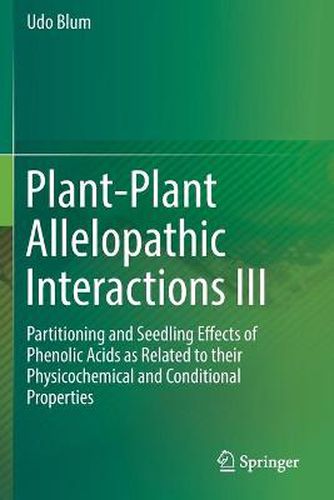Readings Newsletter
Become a Readings Member to make your shopping experience even easier.
Sign in or sign up for free!
You’re not far away from qualifying for FREE standard shipping within Australia
You’ve qualified for FREE standard shipping within Australia
The cart is loading…






This title is printed to order. This book may have been self-published. If so, we cannot guarantee the quality of the content. In the main most books will have gone through the editing process however some may not. We therefore suggest that you be aware of this before ordering this book. If in doubt check either the author or publisher’s details as we are unable to accept any returns unless they are faulty. Please contact us if you have any questions.
This volume continues the retrospective analyses of Volumes I and II, but goes beyond that in an attempt to understand how phenolic acids are partitioned in seedling-solution and seedling-microbe-soil-sand culture systems and how phenolic acid effects on seedlings may be related to the actual and/or conditional physicochemical properties (e.g., solubility, hydrophobicity, pKa, molecular structure and soil sorption/desorption) of simple phenolic acids. Specifically, it explores the quantitative partitioning (i.e., source-sink relationships) of benzoic and cinnamic acids in cucumber seedling-solution and cucumber seedling-microbe-soil-sand systems and how that partitioning may influence phenolic acid effects on cucumber seedlings. Regressions, correlations and conceptual and hypothetical models are used to achieve these objectives. Cucumber seedlings are used as a surrogate for phenolic acid sensitive herbaceous dicotyledonous weed seedlings. This volume was written specifically for researchers and their students interested in understanding how a range of simple phenolic acids and potentially other putative allelopathic compounds released from living plants and their litter and residues may modify soil chemistry, soil and rhizosphere microbial biology, seedling physiology and seedling growth. In addition, this volume describes the potential relationships, where they may exist, for direct transfer of organic compounds between plants, plant communication and plant-plant allelopathic interactions and addresses the following questions: Can physicochemical properties of phenolic acids be used as tools to help understand the complex behavior of phenolic acids and the ultimate effects of phenolic acids on sensitive seedlings? What insights do laboratory bioassays and the conceptual and hypothetical models of laboratory systems provide us concerning the potential behavior and effects of phenolic acids in field systems? What potential role may phenolic acids play in broadleaf-weed seedling emergence in wheat debris cover crop no-till systems?
$9.00 standard shipping within Australia
FREE standard shipping within Australia for orders over $100.00
Express & International shipping calculated at checkout
This title is printed to order. This book may have been self-published. If so, we cannot guarantee the quality of the content. In the main most books will have gone through the editing process however some may not. We therefore suggest that you be aware of this before ordering this book. If in doubt check either the author or publisher’s details as we are unable to accept any returns unless they are faulty. Please contact us if you have any questions.
This volume continues the retrospective analyses of Volumes I and II, but goes beyond that in an attempt to understand how phenolic acids are partitioned in seedling-solution and seedling-microbe-soil-sand culture systems and how phenolic acid effects on seedlings may be related to the actual and/or conditional physicochemical properties (e.g., solubility, hydrophobicity, pKa, molecular structure and soil sorption/desorption) of simple phenolic acids. Specifically, it explores the quantitative partitioning (i.e., source-sink relationships) of benzoic and cinnamic acids in cucumber seedling-solution and cucumber seedling-microbe-soil-sand systems and how that partitioning may influence phenolic acid effects on cucumber seedlings. Regressions, correlations and conceptual and hypothetical models are used to achieve these objectives. Cucumber seedlings are used as a surrogate for phenolic acid sensitive herbaceous dicotyledonous weed seedlings. This volume was written specifically for researchers and their students interested in understanding how a range of simple phenolic acids and potentially other putative allelopathic compounds released from living plants and their litter and residues may modify soil chemistry, soil and rhizosphere microbial biology, seedling physiology and seedling growth. In addition, this volume describes the potential relationships, where they may exist, for direct transfer of organic compounds between plants, plant communication and plant-plant allelopathic interactions and addresses the following questions: Can physicochemical properties of phenolic acids be used as tools to help understand the complex behavior of phenolic acids and the ultimate effects of phenolic acids on sensitive seedlings? What insights do laboratory bioassays and the conceptual and hypothetical models of laboratory systems provide us concerning the potential behavior and effects of phenolic acids in field systems? What potential role may phenolic acids play in broadleaf-weed seedling emergence in wheat debris cover crop no-till systems?